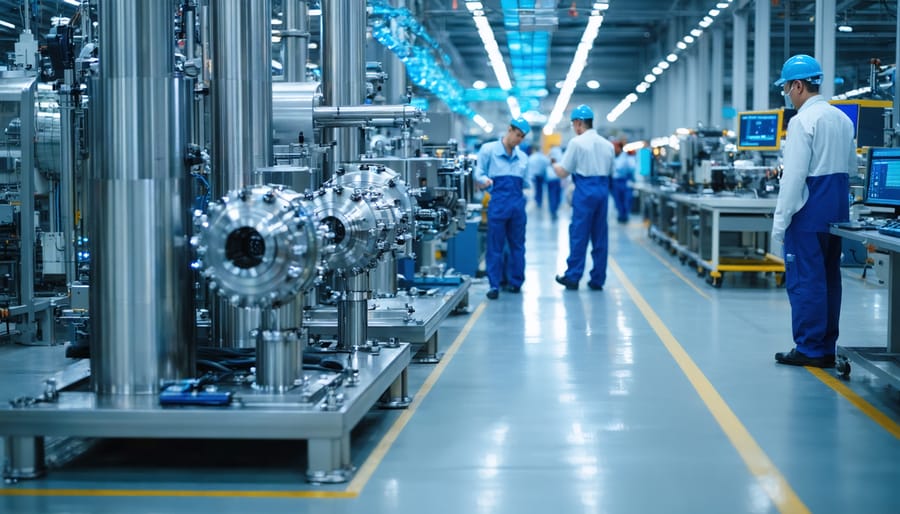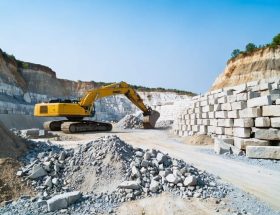Sensors are revolutionizing modern manufacturing by delivering unprecedented precision, efficiency, and quality control in stone manufacturing and other industrial processes. From real-time temperature monitoring in kilns to automated dimensional accuracy checks, these intelligent devices serve as the vigilant eyes and ears of today’s smart factories. By continuously collecting and analyzing critical production data, sensors enable manufacturers to detect irregularities instantly, maintain consistent product quality, and minimize waste. This technological advancement has transformed traditional manufacturing into a data-driven operation where every aspect of the production line can be monitored, adjusted, and optimized with remarkable accuracy. For industry professionals and facility managers seeking to enhance their operations, understanding the strategic implementation of sensor technology has become essential to maintaining a competitive edge in modern manufacturing.
Temperature and Pressure Monitoring in Stone Processing
Real-time Temperature Control
Temperature control plays a crucial role in modern manufacturing processes, particularly in stone fabrication techniques where precision is paramount. Real-time temperature monitoring systems utilize advanced sensors to continuously track and adjust thermal conditions during operations. These sensors provide immediate feedback to control systems, helping prevent tool wear and protect valuable materials from heat-related damage.
In cutting and grinding operations, temperature sensors mounted near cutting edges detect sudden heat spikes that could indicate excessive friction or tool dulling. When temperatures exceed predetermined thresholds, automated systems can adjust cutting speeds or activate cooling mechanisms to maintain optimal operating conditions. This proactive approach significantly extends tool life and ensures consistent product quality.
For processes involving heat-sensitive materials, distributed temperature sensors throughout the manufacturing line monitor thermal variations at multiple points. These measurements enable precise temperature control within specific zones, preventing thermal stress and maintaining material integrity. The system can automatically adjust heating elements, cooling systems, or process speeds to maintain ideal temperatures, reducing waste and improving product consistency while protecting both equipment and materials from thermal damage.
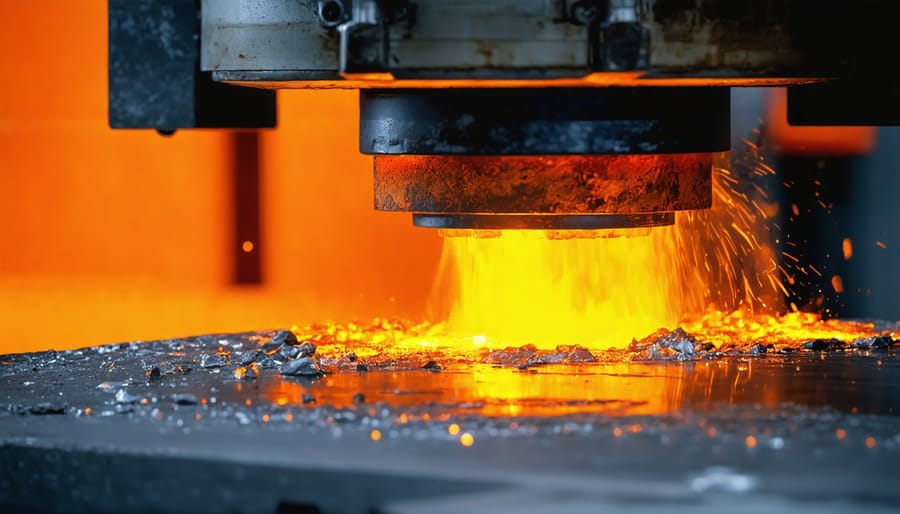
Pressure Optimization Systems
Pressure optimization systems play a crucial role in maintaining consistent quality during stone cutting and polishing operations. These sophisticated sensor networks continuously monitor and adjust pressure levels across manufacturing equipment, ensuring optimal contact between tools and stone surfaces.
Modern pressure sensors utilize piezoelectric technology to detect minute variations in force application. When integrated with automated control systems, they can make real-time adjustments to maintain ideal cutting and polishing pressure. This precision helps prevent common issues like uneven wear patterns, surface scratches, or material waste due to excessive force.
For example, in automated stone polishing lines, pressure sensors mounted on polishing heads provide feedback about the contact force between abrasive pads and stone surfaces. If pressure becomes too high or low, the system automatically adjusts to maintain optimal contact. This consistent pressure application results in superior surface finish quality and extends the life of expensive tooling.
The benefits extend beyond quality control. These systems reduce energy consumption by preventing unnecessary force application and minimize material waste by ensuring consistent removal rates. They also protect expensive equipment by preventing excessive wear and potential damage from improper pressure levels, ultimately leading to more efficient and cost-effective manufacturing processes.
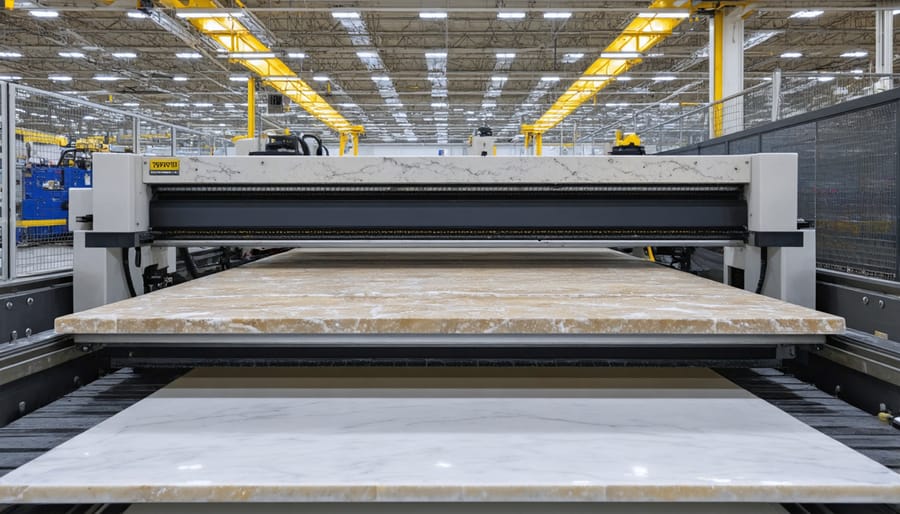
Quality Assurance Through Vision Systems
Surface Inspection Technology
Surface inspection technology has revolutionized quality control in manufacturing processes through advanced vision systems and sensor arrays. These systems use high-resolution cameras and specialized lighting to detect even the smallest imperfections that might be invisible to the human eye. In stone manufacturing specifically, these systems can identify variations in color, texture, and surface finish while products move along the production line.
Modern vision systems employ multiple cameras positioned at different angles to create comprehensive surface maps. These cameras work in conjunction with LED lighting arrays that highlight subtle surface variations, cracks, or irregularities. The captured images are instantly analyzed by sophisticated software that compares them against predetermined quality standards.
The technology can detect issues such as surface pitting, scratches, color inconsistencies, and dimensional irregularities with remarkable precision. For example, in granite countertop production, vision systems can identify natural flaws that might compromise the stone’s structural integrity or aesthetic appeal. The system automatically flags problematic areas for human inspection or rejection.
Real-time monitoring capabilities allow manufacturers to identify and correct process issues before they result in significant waste. The data collected also helps optimize cutting patterns and finishing processes, leading to better resource utilization and consistent product quality. This technology has become particularly valuable in high-volume production environments where manual inspection would be time-consuming and less reliable.
Automated Sorting and Grading
Vision sensors have revolutionized quality control in manufacturing by enabling automated sorting and grading of products with unprecedented accuracy and consistency. These sophisticated sensors use high-resolution cameras and advanced image processing algorithms to inspect products at speeds far exceeding human capability.
In stone manufacturing, vision sensors analyze surface characteristics such as color variations, patterns, veining, and potential defects. The system captures detailed images of each stone piece as it moves along the production line, comparing them against predetermined quality parameters. This allows for real-time classification of stone materials into different grades based on their aesthetic and structural qualities.
The technology can detect microscopic flaws, including hairline cracks, pitting, or inconsistencies in texture that might be missed by human inspectors. By establishing precise digital parameters, manufacturers can ensure consistent quality standards across their entire production output.
Modern vision sensor systems also integrate machine learning capabilities, allowing them to improve their accuracy over time by learning from past classifications. This adaptive approach helps reduce false rejections while maintaining high-quality standards. The data collected during the inspection process provides valuable insights for process optimization and quality trend analysis.
The implementation of automated sorting and grading systems has significantly reduced labor costs while increasing production efficiency. It has also minimized human error and subjective judgments in quality classification, leading to more reliable and standardized product grading.
Moisture and Environmental Control
Humidity Management
Moisture sensors play a crucial role in maintaining optimal humidity levels throughout the manufacturing process, particularly in environments where material quality is sensitive to moisture content. These sophisticated devices continuously monitor ambient humidity and material moisture levels, enabling precise control over environmental conditions.
In stone processing facilities, humidity management is essential for preventing issues like efflorescence, mold growth, and material degradation. Advanced moisture sensors integrated into climate control systems automatically trigger dehumidification or humidification systems to maintain ideal conditions. This is particularly important during cutting, polishing, and storage phases, where consistent moisture levels ensure product quality and structural integrity.
Modern humidity management systems often incorporate wireless sensors that provide real-time data to central control systems. These networks allow manufacturers to establish different humidity zones within the same facility, optimizing conditions for various stages of production. The data collected also helps in predicting maintenance needs and preventing moisture-related quality issues before they occur.
For temperature-sensitive materials, dual-function sensors monitor both humidity and temperature simultaneously, ensuring comprehensive environmental control throughout the manufacturing process.
Environmental Monitoring
Environmental sensors play a crucial role in maintaining optimal conditions throughout the manufacturing process. These sophisticated devices continuously monitor key parameters such as temperature, humidity, dust levels, and air quality to ensure ideal conditions for material handling and processing.
In stone manufacturing specifically, temperature and humidity control are essential for preventing material degradation and ensuring proper curing of adhesives and sealants. Sensors placed strategically throughout the facility provide real-time data that enables automated climate control systems to maintain consistent conditions.
Dust monitoring sensors are particularly important in stone processing environments, where airborne particles can affect both product quality and worker safety. These sensors trigger automated dust collection systems when particulate levels exceed predetermined thresholds.
Advanced environmental monitoring systems also track air quality parameters like volatile organic compounds (VOCs) and carbon dioxide levels. This data helps maintain proper ventilation and ensures compliance with environmental regulations. Many modern facilities integrate these sensors with building management systems for comprehensive environmental control, resulting in improved product quality and reduced energy consumption.
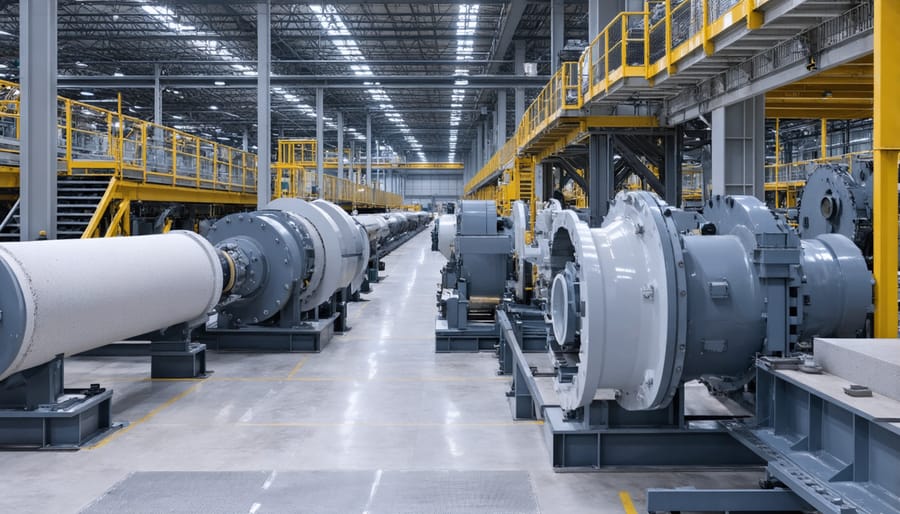
Process Automation and Safety Systems
Automated Material Handling
Modern manufacturing facilities rely heavily on automated material handling systems equipped with sophisticated sensor networks to ensure safe and efficient movement of materials throughout the production process. These systems utilize a combination of proximity sensors, weight sensors, and optical sensors to detect and track materials as they move through conveyor systems, robotic arms, and automated guided vehicles (AGVs).
Proximity sensors monitor the position and spacing of materials on conveyor belts, preventing collisions and ensuring proper positioning for processing. Load cells and weight sensors verify correct material quantities and maintain balanced loads during transport. Vision systems and barcode readers identify and sort materials, directing them to appropriate processing stations.
Safety light curtains and pressure-sensitive mats create protective zones around automated equipment, immediately halting operations if personnel enter restricted areas. Radio-frequency identification (RFID) tags and readers track material movement through the facility, providing real-time inventory management and process optimization.
These sensor systems work together to minimize human intervention, reduce handling errors, and maintain consistent material flow. The integration of these technologies has significantly improved workplace safety while increasing operational efficiency and reducing material waste in modern manufacturing environments.
Safety Monitoring Solutions
Safety monitoring systems powered by advanced sensors play a crucial role in protecting workers and preventing accidents in manufacturing environments. These systems utilize a combination of proximity sensors, motion detectors, and environmental monitors to create a comprehensive safety network throughout the facility.
Proximity sensors installed on heavy machinery automatically halt operations when workers enter designated danger zones, while pressure-sensitive floor mats detect unauthorized access to restricted areas. Motion sensors integrated with emergency shutdown systems provide an additional layer of protection, particularly around automated cutting and polishing equipment.
Environmental sensors continuously monitor air quality, detecting harmful dust particles and chemical vapors that are common in stone processing. These sensors trigger ventilation systems and alert workers when air quality falls below acceptable levels. Temperature sensors prevent equipment overheating and monitor working conditions to maintain safe operational parameters.
Advanced safety systems also incorporate wearable sensors that workers can use to instantly signal emergencies or equipment malfunctions. These devices communicate with central monitoring stations, enabling rapid response to potential hazards. The integration of these safety monitoring solutions has significantly reduced workplace incidents and improved overall operational efficiency in manufacturing facilities.
Real-time data from these safety systems helps facility managers identify potential hazards before they become serious issues, creating a proactive approach to workplace safety management.
Data Integration and Analytics
Real-time Analytics
Real-time analytics transforms manufacturing processes by converting sensor data into actionable insights instantaneously. Modern stone manufacturing facilities leverage sophisticated sensor networks that continuously monitor critical parameters such as cutting speeds, material density, and equipment performance. This data feeds directly into advanced analytics platforms, enabling immediate adjustments to optimize production efficiency.
By implementing real-time monitoring systems, manufacturers can detect and respond to process variations before they impact product quality. For instance, when sensors detect subtle changes in cutting tool vibration patterns, automated systems can adjust cutting speeds or initiate tool replacement procedures without manual intervention. These process optimization solutions significantly reduce waste and improve overall equipment effectiveness.
The integration of machine learning algorithms with sensor networks enables predictive capabilities, allowing systems to anticipate potential issues and automatically adjust parameters for optimal performance. This proactive approach minimizes downtime, ensures consistent product quality, and maximizes resource utilization throughout the manufacturing process.
Predictive Maintenance
Predictive maintenance revolutionizes manufacturing by utilizing sensor data to anticipate and prevent equipment failures before they occur. Advanced sensors continuously monitor critical parameters like vibration, temperature, pressure, and electrical current in machinery and production lines. This real-time data collection enables manufacturers to identify patterns and anomalies that might indicate impending issues.
For example, accelerometers can detect unusual vibration patterns in cutting tools that signal imminent failure, while thermal sensors monitor bearing temperatures to prevent overheating. By analyzing this data through sophisticated algorithms, maintenance teams can schedule repairs during planned downtime rather than dealing with unexpected breakdowns that halt production.
The benefits of predictive maintenance are substantial: reduced maintenance costs, increased equipment lifespan, minimized production disruptions, and optimized spare parts inventory. Studies show that predictive maintenance can reduce machine downtime by up to 50% and extend equipment life by 20-40%. This proactive approach ensures consistent product quality while maintaining operational efficiency, making it an essential component of modern manufacturing processes.
The implementation of sensors in manufacturing processes has revolutionized the way industries operate, particularly in natural stone production. By enabling real-time monitoring, quality control, and process optimization, sensors have become integral to achieving sustainable manufacturing practices. As technology continues to advance, we can expect to see even more sophisticated sensor applications, including AI-integrated systems and predictive maintenance capabilities. The future trends point toward increased automation, improved energy efficiency, and enhanced product quality through sensor networks. These developments will not only boost productivity but also reduce waste and environmental impact, making sensor technology an invaluable investment for modern manufacturing facilities.

